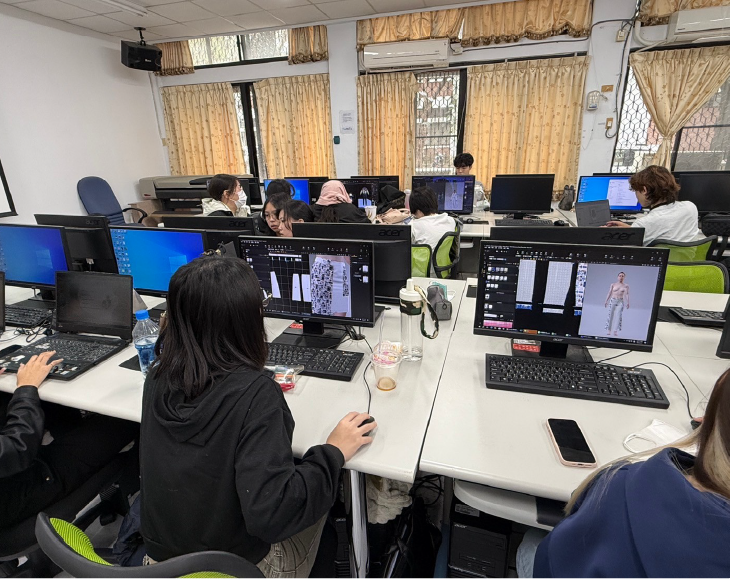What is 3D Fashion Design and How Does it Shape Fashion's Future?
Discover how 3D fashion design transforms the industry with enhanced sustainability, efficiency, fit accuracy, customization, and innovation.
April 2, 2025

The future of fashion is digital, and students at the National Pingtung University of Science and Technology (NPUST) in Taiwant got hands-on experience with digital product development in a five-day intensive workshop led by Jenny Chang in collaboration with Browzwear. With 48 final-year students from the Department of Fashion Design and Management, the workshop explored how digital tools like VStitcher enhance design, fitting, and creative exploration.
Before the workshop, students completed Browzwear University (BWU) 101/201 courses between October and December, gaining foundational knowledge in digital fashion design. Some students from the Fashion Design Group also attended weekly 3-hour practical VStitcher sessions, giving them a head start in applying digital tools to their creative projects.
On November 31, 2023, after receiving 21 sets of VStitcher donated by Great Giant, a cohort of 20 fashion design students began hands-on training through an industry-academia collaboration, learning alongside their instructor.
Meanwhile, Professor Chen developed the course materials and officially launched the training program. During the workshop, all 20 students expanded their final year projects using 2D Systems and VStitcher to create new designs. For many, however, the January 6-10 workshop marked their first real experience using VStitcher—an exciting shift from online tutorials to hands-on digital creation.
Each day was structured to help students gradually build their designs, refine their skills, and prepare for final presentations.
On the first day, students explored digital fashion creation by extracting styles from Browzwear's Cloud Library and experimenting with styling, color matching, and rendering. They also engaged in group discussions to define their design themes and collaborative directions, setting the foundation for their projects.
On the second day, each group selected a style from the Cloud Library and began refining their designs. They modified avatars, adjusted patterns, and altered silhouettes to better align with their chosen concepts, bringing their creative visions closer to realization.
On the third day, students personalized their designs by incorporating custom artwork, colors, and textures. Some explored the use of AI to convert plan views into 3D FBX files, integrating them into VStitcher for a more dynamic design process. Their creativity extended beyond clothing, with projects ranging from shoe design and necklace making to mask development, showcasing the versatility and limitless possibilities of digital fashion.
On the fourth day, students dedicated long hours to finalizing their designs, making refinements, and ensuring every detail aligned with their vision. Working late into the evening, they perfected their projects and submitted their final reports by midnight. Many took the opportunity to expand their graduation collections, using VStitcher to create additional pieces beyond their original designs, pushing the boundaries of their creativity and technical skills.
On the fifth and final day, students presented their digital designs, showcasing the skills they had developed throughout the workshop. They shared insights into their creative process, reflecting on how digital tools had transformed their approach to design. The presentations highlighted their ability to experiment, refine, and innovate, demonstrating the impact of digital fashion technology on their learning experience.
One of the biggest takeaways from the workshop was how students discovered new possibilities for their work through digital tools. For some, VStitcher provided an intuitive way to visualize and correct design flaws in real time, making the learning process more efficient and insightful. Others initially planned static exhibits, expanded their work digitally and saw its potential for commercial value, transforming conceptual designs into viable fashion products.
One student used the strokes of their Chinese name as inspiration, converting the design into a totemic fabric pattern. Through AI-to-FBX conversion, they integrated their necklace design into VStitcher, allowing it to be worn on avatars and expanding the possibilities for digital accessories. These projects demonstrated how digital fashion tools can push creative boundaries, turning ideas into dynamic, scalable designs.
This workshop proved that digital tools like VStitcher aren't just about visualizing garments - they are about unlocking new creative and business opportunities.
80% of students praised the efficiency of digital product development, noting how it helped them assess design viability and commercial potential.
Fit testing and structure visualization became more intuitive, making learning more effective.
Design iteration became limitless, allowing students to experiment without the constraints of physical sample costs.
By integrating digital product development into education, students are not just learning new tools—they’re preparing for the future of fashion.
Discover how 3D fashion design transforms the industry with enhanced sustainability, efficiency, fit accuracy, customization, and innovation.
Discover four proven strategies to seamlessly integrate new 3D fashion design technology into your workflow, boosting efficiency and innovation.
Discover Browzwear’s new features that help fashion teams work faster, cut errors, and improve collaboration from design to production.